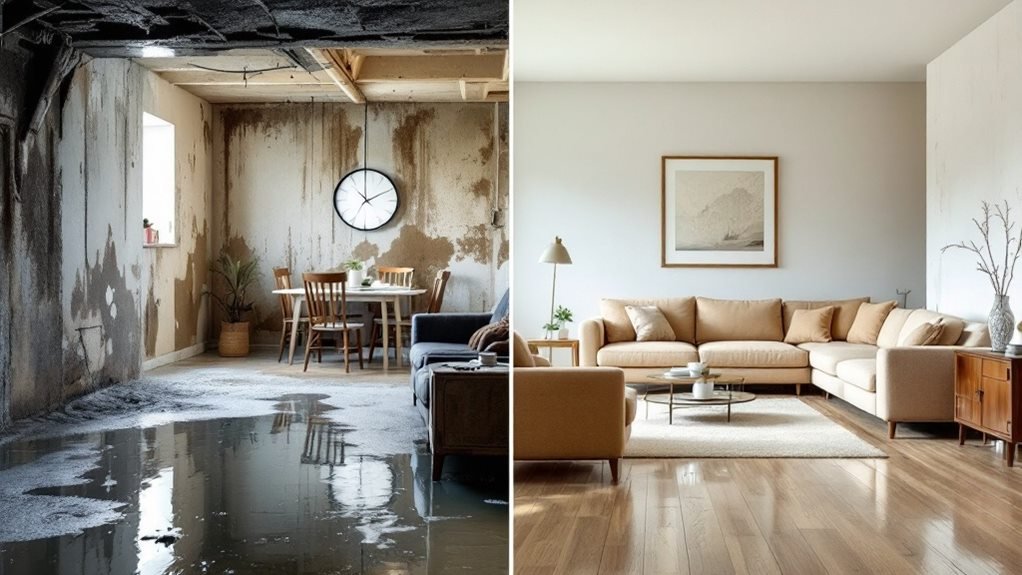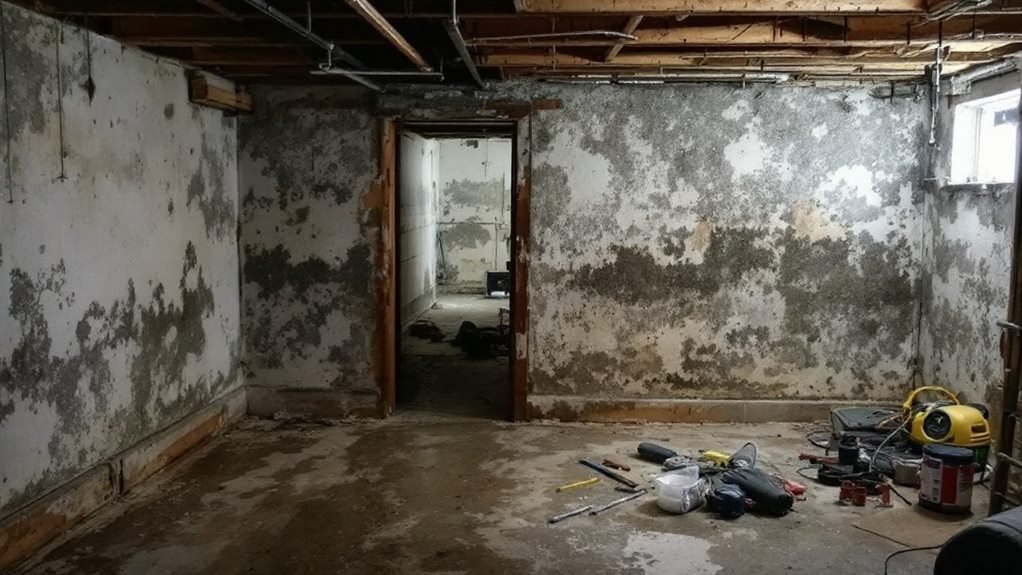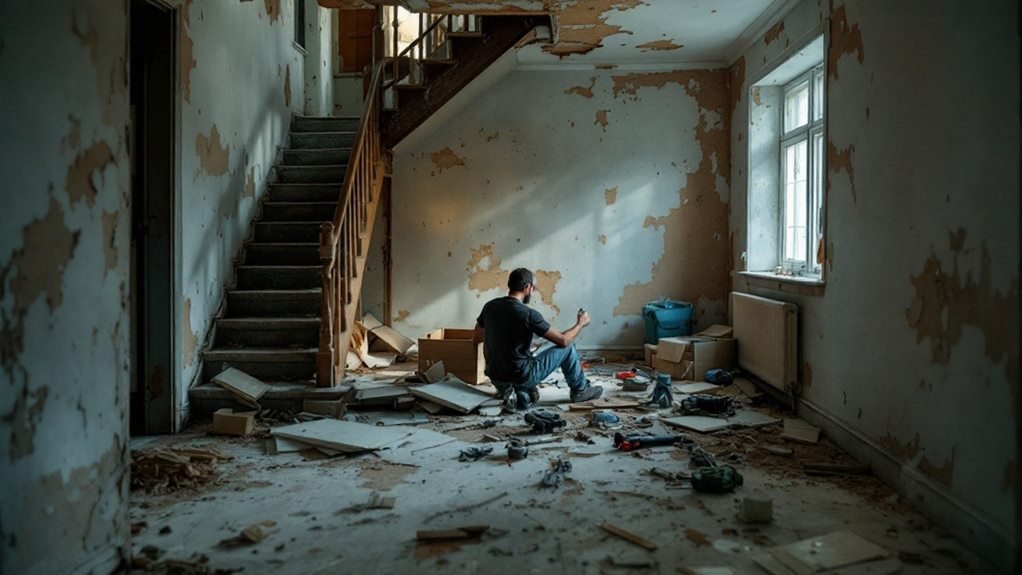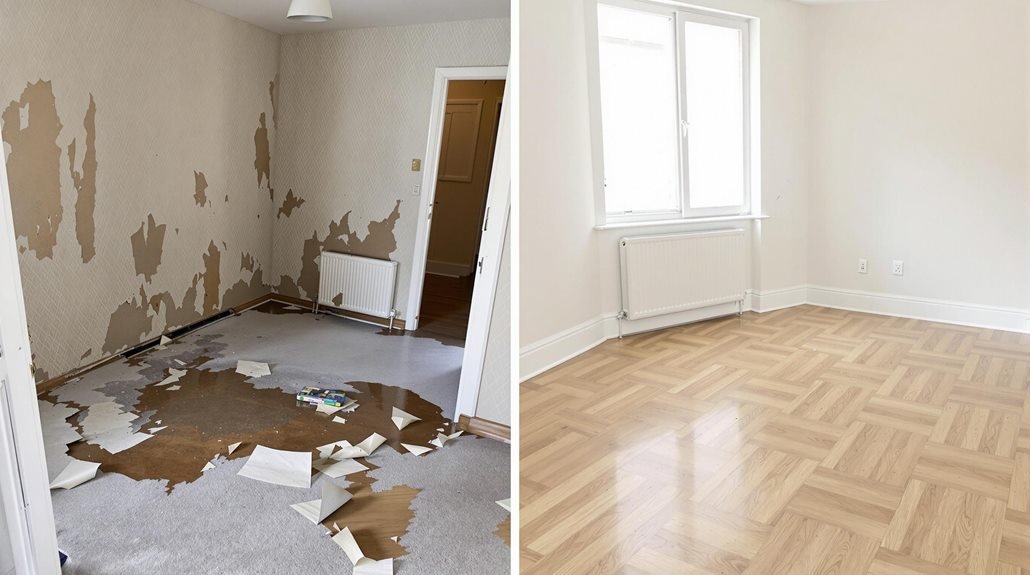When you face water damage, choosing between restoration and replacement isn't always straightforward. You've got to weigh factors like the severity of the damage, your budget, and the long-term effects on your property. Restoration might save you some cash and keep your home's character intact, but it can likewise lead to hidden issues like mold. On the other hand, replacement offers a fresh start with new materials but can strain your finances. So, how do you know which path is right for your situation? The answer might surprise you.
Understanding Water Damage Types

Water damage often occurs in various forms, and understanding these types is crucial for effective restoration. You might think water's just water, but trust me, it has a knack for bringing chaos into your life. The first step is flood categorization, which breaks down the damage based on the source and contamination level—think of it as sorting laundry, but way less fun. We've got clean water (Category 1), gray water (Category 2), and black water (Category 3), each requiring different approaches for restoration.
Next, you'll need a moisture assessment. This involves using specialized tools to measure moisture levels in walls, floors, and other materials. It's like a doctor checking for a fever, but instead, you're determining if your drywall's about to throw a water balloon party.
Understanding these aspects not only helps you tackle the problem at hand but likewise prevents future mishaps. So, whether you're dealing with a leaky roof or a rogue toilet, knowing the type of water damage can make all the difference. After all, nobody wants to face a soggy situation without a plan—unless you're a sponge, but I doubt that's your goal!
Pros of Restoration
When you choose restoration over replacement, you're often looking at a cost-effective solution that can save you significant money. It likewise helps preserve the original structure of your property, maintaining its integrity and value. Plus, with a quick turnaround time, you can get back to your normal life sooner, minimizing the disruption water damage can cause.
Cost-Effective Solution
In the aftermath of water damage, choosing restoration over replacement can greatly reduce your overall costs. Instead of shelling out a fortune for new materials and installations, restoration provides affordable options that can save you a significant chunk of change. It's like choosing to fix your old car instead of buying a shiny new one; you might keep some of that cash for a rainy day—or perhaps a sunny vacation!
When you opt for restoration, you're additionally engaging in smart financial planning. You'll minimize expenses related to labor, materials, and disposal fees associated with replacing damaged items. Plus, many restoration services offer flexible payment plans, making it easier on your wallet. You can avoid the dreaded "I'll have to sell a kidney!" budget conversations.
Moreover, restoration can often be done quickly, meaning you'll get back to your normal life sooner without straining your finances. So, while it might feel like a disaster today, remember that a cost-effective solution is right around the corner. By choosing restoration, you'll not only protect your finances but also your sanity—because who really wants to deal with a massive financial overhaul?
Preserves Original Structure
Choosing restoration not only helps your wallet but also maintains the integrity of your property. When you opt for water damage restoration, you're preserving the original materials that define your home's unique character. Whether it's the vintage hardwood floors or the meticulously crafted moldings, these elements contribute to your property's charm.
Restoration processes are designed to minimize disruption while ensuring that structural integrity remains intact. Skilled technicians assess the damage, carefully treating affected areas without compromising the underlying framework. This approach means you won't have to deal with the headaches of a complete overhaul or the risk of structural instability that can come with replacement.
Plus, there's a certain satisfaction in knowing that your home's history is being honored. You're not just restoring a building; you're preserving memories and maintaining the spirit of the space where you've shared countless moments. And let's face it—who wants to explain why their living room suddenly looks like a modern art installation? So, if you're looking to keep your home's character intact, restoration is the way to go. You'll save money and keep that charming vibe alive!
Quick Turnaround Time
Time is often of the essence in water damage situations, and restoration offers a rapid solution that minimizes disruption to your life. When you face an unexpected deluge, an emergency response team can spring into action, often arriving within hours to assess the damage and begin work. This swift response sets the tone for an efficient restoration timeline, allowing you to return to your normal routine sooner rather than later.
Choosing restoration means you're not just salvaging your space; you're likewise cutting down on the time spent in limbo. Instead of waiting for replacements to arrive and be installed, restoration methods can often salvage your existing materials, getting you back on track faster. Think of it as a speedy pit stop in a race — the quicker you're back on the track, the less time you spend in the slow lane.
Cons of Restoration

While restoration may seem like a cost-effective solution, it carries significant risks, particularly the potential for mold growth if moisture isn't completely addressed. You might find that, over time, the expenses associated with ongoing maintenance and repairs can surpass the initial savings. It's vital to weigh these long-term costs against the immediate benefits of restoring damaged materials.
Potential for Mold Growth
When water damage restoration is pursued, the potential for mold growth often looms large. Mold loves damp, dark places, and if you don't act quickly, your home could become its new favorite hangout. You might think you've tackled the problem, but unbeknownst to you, mold might be setting up a party in the walls.
Here's a quick look at some mold prevention strategies you can employ:
| Mold Prevention Strategies | Humidity Control Measures |
|---|---|
| Regularly inspect for leaks | Use dehumidifiers in damp areas |
| Clean gutters to prevent pooling | Keep indoor humidity below 50% |
| Use mold-resistant materials | Ventilate bathrooms and kitchens |
| Quickly dry wet areas | Fix any water damage promptly |
| Educate yourself on mold types | Monitor humidity levels regularly |
Don't forget, though, that even with the best mold prevention strategies, you still need to stay vigilant. A little moisture can turn into a moldy mess faster than you can say "fungus among us." So, while restoration can save you money, mold could turn your home into an unwelcome ecosystem.
Higher Long-Term Costs
Choosing to restore rather than replace water-damaged materials can sometimes backfire, leading to higher long-term costs. While restoration might seem like the cheaper option upfront, it can turn into a financial black hole. Think about it: if the original materials aren't fully dried or treated, you're opening a Pandora's box of future issues—hello, mold! That means you could end up spending more down the line on repairs and long-term maintenance than you would have on a proper replacement.
Plus, let's not forget the insurance implications. If your insurer sees that you've opted for a patch job instead of a solid fix, they might raise an eyebrow—and your premiums. It's a bit like trying to save money by buying a cheap umbrella that flips inside out during a storm. You might save a few bucks now, but you'll be soaked later.
In the end, while restoration might seem like the easy way out, you could find yourself in a never-ending cycle of repairs. So, weigh your options carefully—your wallet will thank you later!
Pros of Replacement
Replacement offers a sense of certainty that can be invaluable after experiencing water damage. You know exactly what you're getting—brand new materials that haven't been compromised. This peace of mind is especially comforting when you consider how water can warp, mold, and typically wreak havoc on your home's integrity.
From an environmental impact standpoint, choosing to replace damaged items can sometimes lead to better sustainability options. Modern materials often come with eco-friendly certifications, allowing you to contribute to a healthier planet while additionally revitalizing your space. Plus, you get to pick out new items that align with your aesthetic considerations. Want that trendy open-concept kitchen or a cozy living room vibe? Now's your chance to design without the baggage of damaged goods.
While it may feel like you're throwing a party for your wallet, the long-term benefits of replacement often outweigh the initial costs. You're not just investing in materials; you're investing in a safe, beautiful living environment. So go ahead—embrace the upgrade! Your home deserves a second chance, and let's face it, so do you.
Cons of Replacement

One major drawback of opting for replacement after water damage is the substantial financial burden it can impose. Replacing flooring, drywall, or even appliances can send your wallet into a tailspin faster than you can say "insurance implications." Sure, your insurance might cover some costs, but prepare for the possibility of deductibles and limits that can leave you feeling like you're being pranked by your own policy.
Additionally, let's not forget the environmental impact. Replacing items means more waste, and that's not great news for Mother Earth. Those perfectly good materials that could've been restored end up in a landfill, contributing to an ever-growing mountain of debris. You might be thinking, "Why should I care about the planet when I've got soggy carpet?" Well, you might just find that your eco-conscious side gives you a warm, fuzzy feeling, even amid the chaos.
Lastly, the hassle of finding replacements can be exhausting. From researching products to coordinating deliveries, it can feel like you're running a miniature construction site. So, weigh the pros and cons carefully before you decide to plunge headfirst into that replacement pool!
Making Your Decision
After weighing the financial strain and environmental consequences of replacement, it's time to evaluate your specific situation and decide the best course of action. First, check your insurance coverage; it might just be your golden ticket. If your policy covers restoration, you could save a pretty penny, and your bank account will thank you. Plus, think about the environmental impact of tossing out perfectly good materials.
Now, consider the extent of the damage. If it's just a minor leak, restoration might be your best bet—after all, who needs a new floor when your old one just needs a little TLC? On the other hand, if you're staring at a soggy structure resembling a science experiment gone wrong, replacement could be your only option.
Frequently Asked Questions
How Long Does the Water Damage Restoration Process Typically Take?
The water damage restoration process usually takes 3 to 7 days, depending on the drying techniques used. If you're lucky, you'll be back to normal sooner, but patience is key—water loves to linger!
Will Insurance Cover Restoration or Replacement Costs?
Your insurance policies might cover restoration costs, but not always replacement. Check your restoration coverage; it often depends on the severity of damage. Remember, finding humor in leaks can lighten the stress—just don't laugh too hard!
How Can I Prevent Future Water Damage?
Imagine a sponge soaking up water—don't let your home be that sponge! Utilize waterproofing techniques and prioritize regular maintenance. It's like giving your house a raincoat, keeping it dry and happy for years to come.
Are There Any Health Risks Associated With Water Damage?
Yes, there're health risks with water damage. Mold growth can trigger allergies or respiratory issues, and compromised structural integrity might lead to accidents. It's no joke—acting quickly protects both your health and home.
What Should I Do Immediately After Discovering Water Damage?
Uncovering water damage's like finding a surprise guest at a party. First, take emergency actions: turn off power, stop the water source, and perform an initial assessment. Then, call a professional—don't wait to party with mold!
Conclusion
In the end, choosing between restoration and replacement is like steering through a stormy sea; you must weigh the risks and benefits carefully. If you opt for restoration, you're mending the fabric of your home, but be prepared for potential hidden dangers. If you choose replacement, you're building a sturdy ship to weather future storms, yet it may come at a higher cost. Trust your instincts, assess your situation, and let the right choice guide your journey to recovery.


Recent Comments